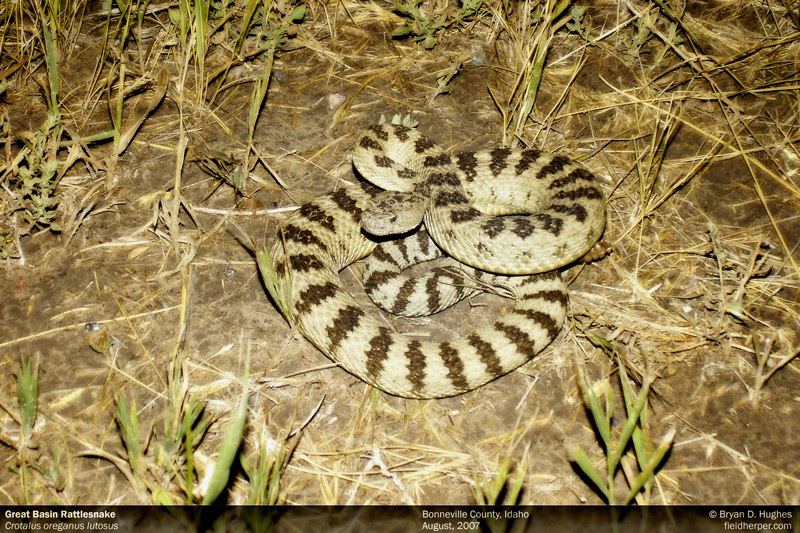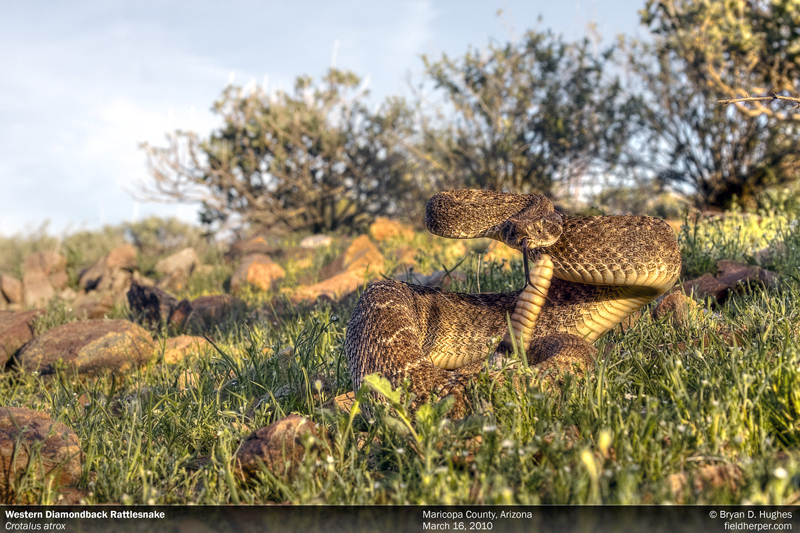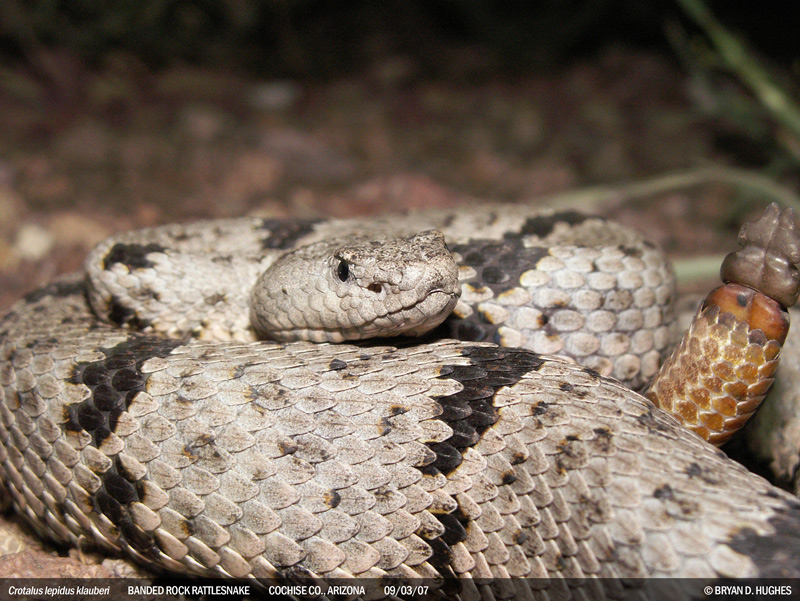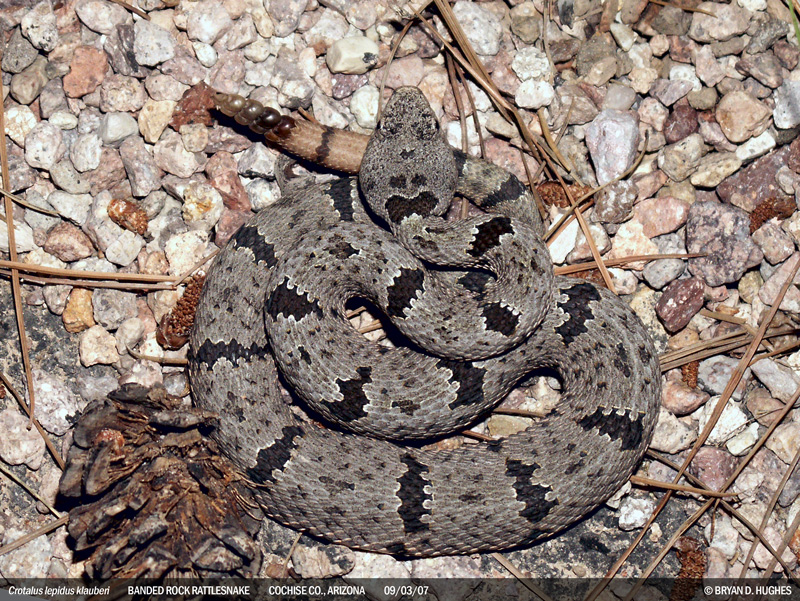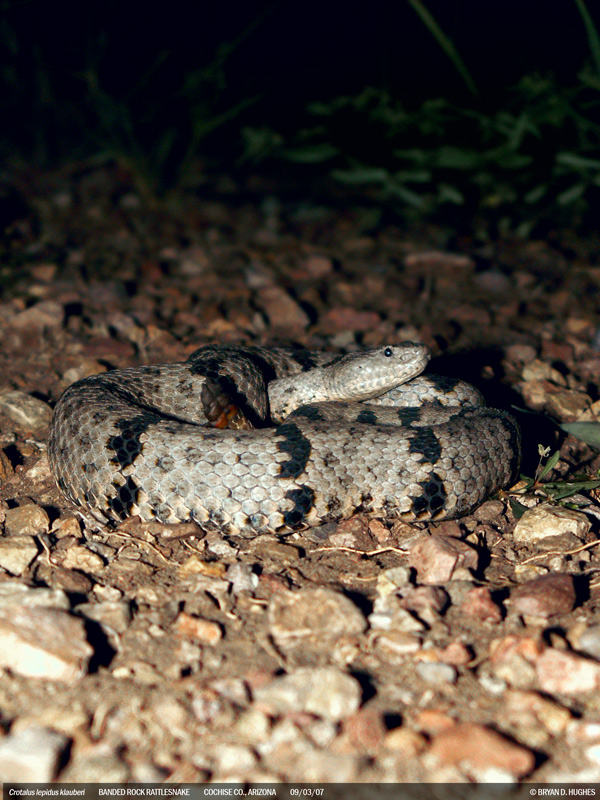I found a Western Diamondback Rattlesnake, Crotalus atrox, a couple of miles from my home in Anthem, Arizona. We’ve had a rather wet year, so temperatures have remained cool and I haven’t seen as much in the early part of the year as I did in 2009, but this year will be a killer! Lots of moisture means lots of snakes, and Spring is looking good.
A Young Ridge-Nosed Rattlesnake in Arizona
The Ridge-Nosed Rattlesnake, Crotalus willardi, is probably the most sought-after rattlesnake in the country. They’re small and hard to find unless you know what you’re doing, which I officially don’t. I’ve seen less than 10 total. They’re awesome little snakes with a look that seems surprising they’d be in the US at all, with their lance shaped head and high-contrast white facial markings. I didn’t see one at all in 2009 (though I only looked once, to be fair), and I’ll have to fix that in 2010.

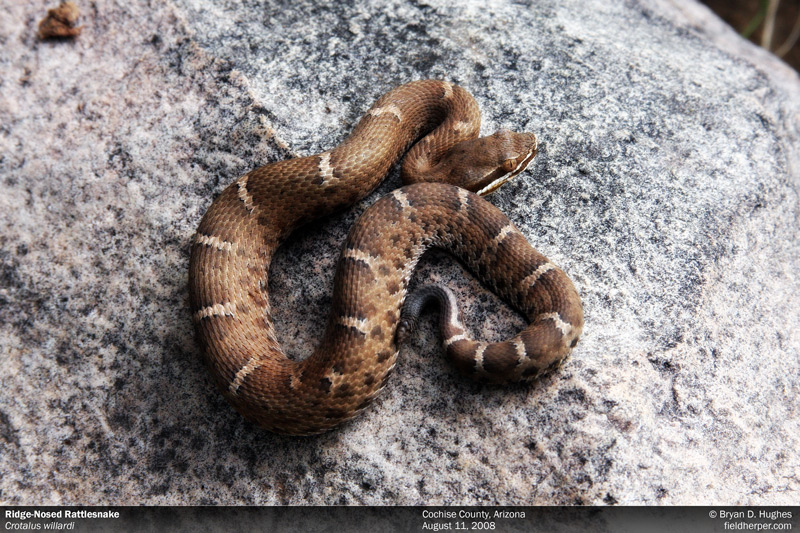
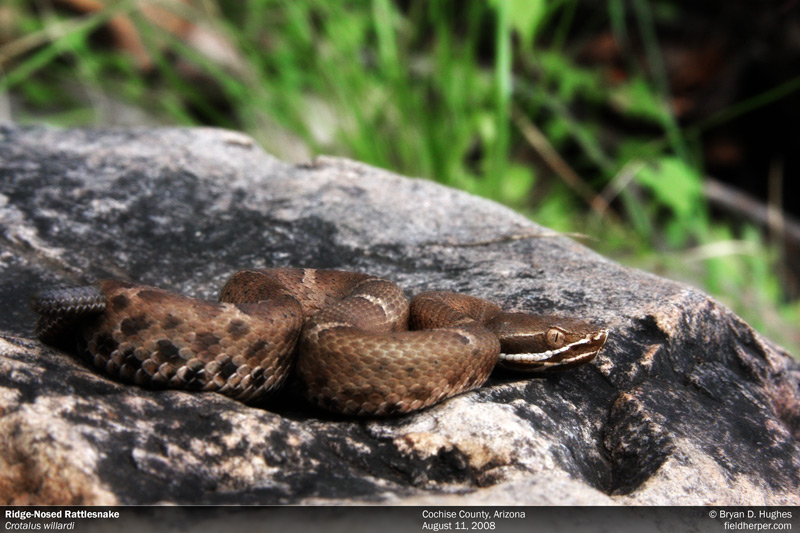
An Exceptionally Green C. lepidus
A Western Banded Gecko, The Most Squished Animal on Earth
These little geckos are all over the roads most of the year and it’s easy to forget how cool they are and get out of the car to chase them around to get some pictures. This is a Western Banded Gecko, Coleonyx variegatus, one of the only geckos with eyelids. Their skin is covered with tiny round scales and feels so soft it’s hard to tell where the air ends and the lizard begins. As the title also implies, they’re probably the number one smashed critter on Arizona highways in the summer.

Book Review: A Guide to the Rock Rattlesnakes of The United States
I’m planning a month-long trip to New Mexico this Spring, and the release of this book couldn’t have been timed better. A Guide to the Rock Rattlesnakes of the United Snakes, by Michael Price, got here a few days ago and I’m glad I bought it.
First, this is, as Mr. Price put it, “intended to be a ‘science’ book”, and that it isn’t. The majority of the book is photography by the author and a few other field herpers, sprinkled with a couple pages of text here and there that more or less give some context to the next grouping of photos. Though lean on the science, what is there can be pretty useful. The phenotype information is about as detailed as the book gets, but this is very useful when combined with the maps, habitat shots, and various shots of lepidus from different mountain ranges.
The real stand-outs are the animals, of which Michael Price has done a great job showing off the amazing variation of the species. The photography is very good, though I do wish there were a few more scenic shots of the animals in their environments. The part that is personally most useful are the habitat shots. Each mountain range is a little different, and it takes some work to find that sweet spot where everything is just right for snakes. I even recognized one rock photographed in the Guadalupe Mountains, where every time I drive by, makes me think “I bet that place is crawling with leps.”. Now I know for sure it is, and this will be one of the first places I visit on my trip.
All in all I think it’s a great book to have if you’re a lepidus lover, but not the best if you have a more casual view of them. While pages and pages of pictures of different rock rattlesnakes is very interesting to field herpers, it might not be the best way to spend $25 if you don’t actually plan on someday visiting all of these.
A Guide to the Rock Rattlesnakes of the United States is available on Amazon.com, and in the bookstore on this site.

2 Klaubs from the Huachuca Mountains
Big Fat Tiger Rattlesnake in the Superstition Mountains
This is the second live Tiger Rattlesnake, Crotalus tigris, I ever found in Arizona. I was a moron and forgot to load up my headlamp and camera with new batteries, so had to do a bit of a shuffle to get him to hold still while I got my crap together. These snakes are awesome and the first few I found just looked so weird to me with their tiny heads and fat bodies. True specialists.

A Trio of Mojave Rattlesnakes
Here are 3 typical-looking Mojave Rattlesnakes, Crotalus scutulatus, in Arizona. This is one of the more common snakes I encounter in the wet months of the year.
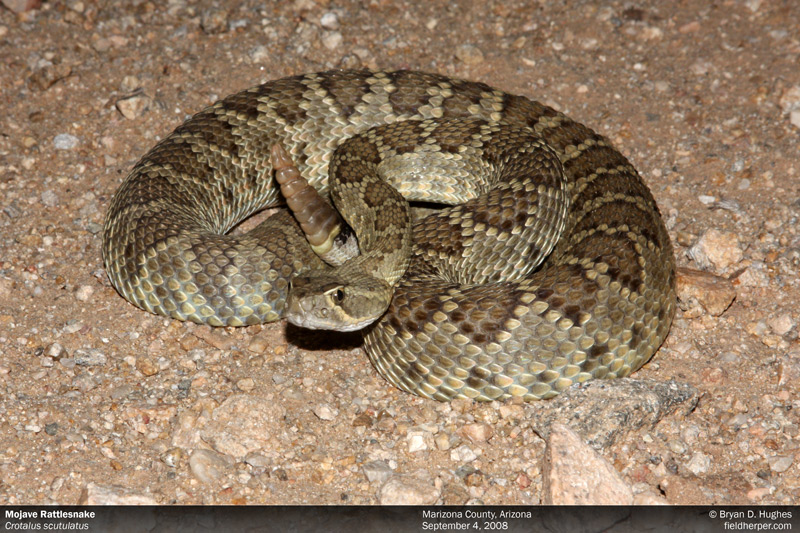

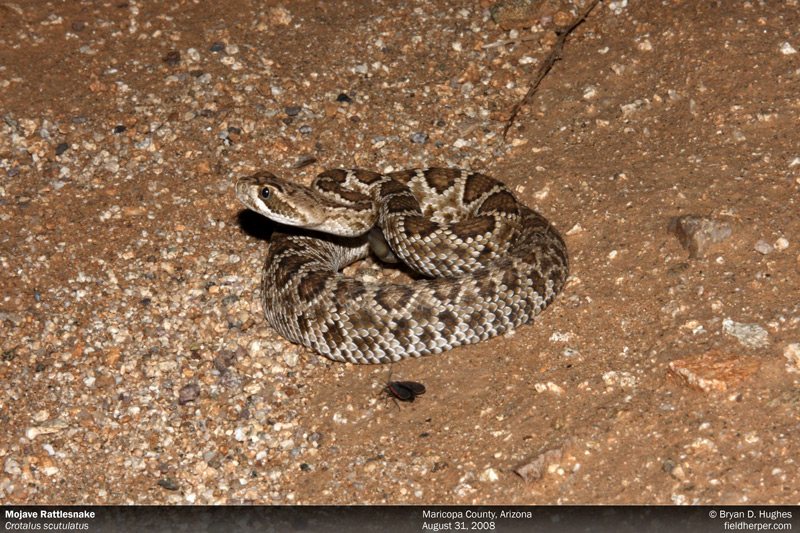
A Young Striped Whipsnake Mid-Shed
My wife and I found this baby Striped Whipsnake, Coluber taeniatus, under some asphalt shingles out in the middle of the woods for some reason. His clouded eyes, filled with fluid to help him slip out of his old skin, made this already aggressive species even more pissy. His close cousin Coluber bilineatus has had more teeth in me in these last years than any other species. These snakes are assholes.


One Pissed Off Rattlesnake
I was out on the last day in August with my good herping friend Kris Haas dodging flash floods and racking up the snakes when we found a neonate Mojave Rattlesnake, Crotalus scutulatus, making his way across the road. I slammed on the brakes, dropped my window, and sent us backwards to confirm the snake and park for photos. Before I was able to turn off the car we could hear the familiar “ssssshhhhhhhhhhhhhhhhhhhhchchchc” way off into the desert to our right; it was another snake. We couldn’t believe it, by the sound of it the snake was qay off in the distance, and it seemed unlikely it could possibly be rattling at us at this distance. Kris went off to catch the little guy, and I went off into the bushes to find the noisy guy.
He was easy to find; I just followed the sound. He was under a tree a good 100′ or more from where we first heard him inside the truck with the engine running. Crazy luck.
Here’s the little guy, followed by the angry noise maker.


Watch Your Step
A young Mojave Rattlesnake, Crotalus scutulatus, hiding in the grass in Southern Arizona. If there were any snake in Arizona that I would step on if I had to, this species would not be it.
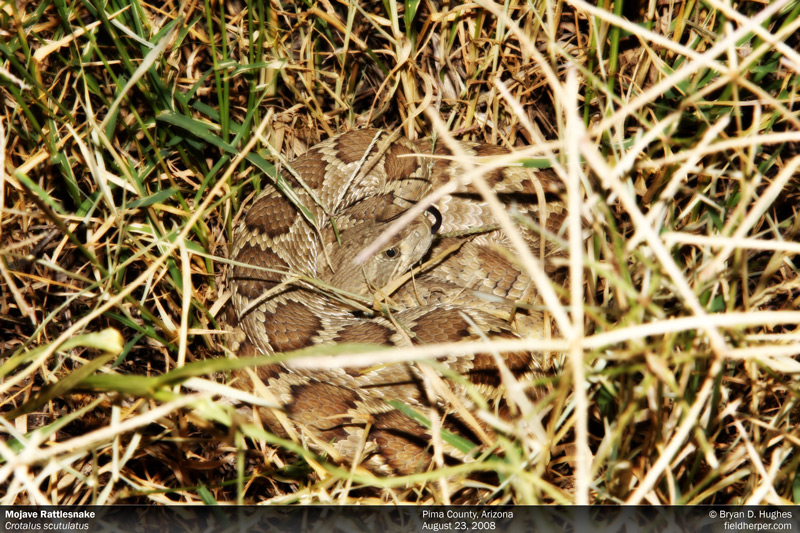
A Big Great Basin Rattlesnake from Bonneville County, Idaho
Here’s a rarity for this website and me in general, a rattlesnake found far from Arizona. I went up to my 10 year highschool reunion in 2007, but ended up spending most of my time in the hills surrounding my hometown armed with a lot more knowledge about how to find the local rattlesnakes. This one was as big as any rattlesnake I’ve ever seen in Arizona, and extremely aggressive towards me. It’s a Great Basin Rattlesnake, Crotalus oreganus lutosus, which can be found in Arizona as well, though I have not yet gone looking for them. I found a few others in my time up there, and I’ll post those at another time. My camera gear and photographic skill were both severely lacking at the time, so it’s hard to get over myself on some really unfortunate missed shots.
